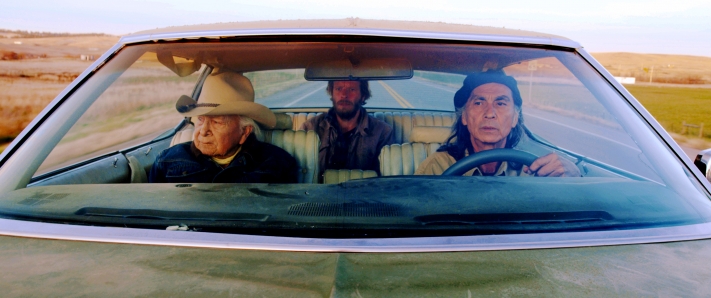
Sean MacLachlan: Neither Wolf Nor Dog is your fourth Native American project, shot on Pine Ridge Reservation. How and where did your interest in Native American culture start? Did being a European - an outsider rather than an American - alter how you were perceived on the reservation?
Steven Lewis Simpson: There is nowhere on earth that I have been welcomed more than on Pine Ridge Indian Reservation. When I first went there in the summer of 1999, I was shown around Wounded Knee by a local, then went to Camp Justice, which was a protest camp next to the notorious liquor town, White Clay. I then followed folks up to the house of the most famous American Indian activist of the 20th Century, Russell Means, who asked me to film three days of political meetings there. That was my first three hours on the reservation, and I was immediately in the heart of things. The relationship with the community has just gotten richer and deeper from there. Certainly, Europeans are far more embraced there, as invariably, we are much more open and looking to make friends. That perspective was crucial in being able to see how awkward many white Americans are there [on the reservation]. It allowed me to create a far greater depth to the character of the white author.
SM: What were your first impressions of Kent Nerburn's novel? Were you immediately compelled to tell that story through the medium of film?
SLS: Kent Nerburn approached me with his novel and it took me quite a while to read it. I normally just create my own original stories and like strong narrative arcs, but this story resonated with me, and I saw that it was an interesting way to explore the contemporary echoes of the Wounded Knee Massacre. Little did I know that Dave Bald Eagle would take that further than we could have imagined.
SM: You've said previously that you were exceptionally pleased with the three actors you cast to play Nerburn, Dan and Grover, the film's central trio. Could you tell us a bit more about the characters, and what the actors themselves brought to their respective roles?
SLS: I could have auditioned thousands of actors for the role of Kent Nerburn, but I only auditioned Christopher Sweeney. I saw him in a play and there was just something about him that felt right. It was pure instinct and it proved to be a very good one. With Richard Ray Whitman, I kept seeing him in various films in the lead-up to the shoot and I invariably found him to be so compelling on screen. But with Dave Bald Eagle, I don’t for a second believe that anyone else could have touched the role and done it justice. It was meant for him. He was closer to the events of the Wounded Knee Massacre, through his family, than even the character he was playing. We had him improvise the climax of the film at Wounded Knee and he spoke from so deep in his heart that at the end of it he said, “I’ve been holding that in for 95 years”.
SM: The actual shooting of the film, with a low budget and a small crew, sounds demanding - what were the major challenges you faced on the 18-day shoot?
SLS: The main challenge of the shoot was logistical. I did all the production work myself and so at night I was often trying to figure out how to cast roles or find locations for the following day. A lot of it was that random. We had a 1973 Buick that also decided to torment us a lot during the shoot, and our lead actor, Chris Sweeney, spent a lot of the spare time on the shoot bringing the car back to life. When you are filming out in South Dakota the weather can also mess up a shoot, but we were extremely lucky. Because I knew the reservation so well, the rest of it happened amazingly smoothly. The land is so stunning there that it makes it easy to shoot fast and still come up with an attractive film, as it is hard for it not to look stunning.
SM: The events of the film are astonishing, but the distribution was also unique. What was the motivation behind releasing the film yourself?
SLS: They say that there are somewhere around five thousand feature films a year submitted to the Sundance Film Festival. Most from the US. Almost all of them will never see the inside of a cinema on a commercial release. We were heading in the same direction, but I knew there was a strong audience for the film. Little did I know that it would be far broader than I’d imagined. The film has already grossed many times my highest estimates for the film. It has all come about because the audience feels so passionately about the film and they champion it and spread the word. Producers don’t normally see much of the money a film makes in distribution so by handling it myself, it has allowed me also to bring in some income that can also finance some of my next movie. It is a pretty unique position for an independent film-maker.
SM: So far the film has run in over 200 cinemas and over 200 other venues in the US and Canada, regularly outperforming Hollywood big-budget blockbusters. What do you think viewers are responding to? What can British viewers expect?
SLS: The audience is first and foremost falling in love with Dave Bald Eagle on screen. His performance is melting their hearts, and it is as unforgettable as any character you are likely to see on screen. But this is who he was in life, and more. He was a truly magical human being. A joy to be with. The advantage of having such a star is that people are much more open to listening to what he talks about in the film, as they are listening with their hearts as well as their heads. It is a film that creates greater understanding between peoples. Most people in Europe have an instant empathy with Native Americans, unlike in the US, where prejudice and racism against them is still a huge problem. So it has been wonderful seeing such high turnouts in our UK showings.



